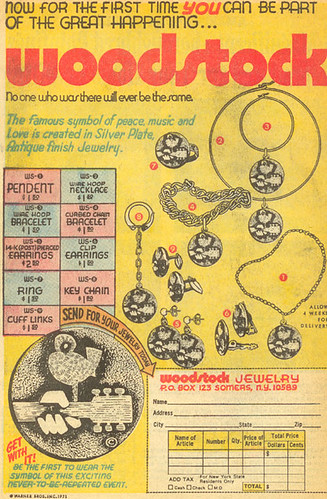celebrating woodstock in a war comic
 Judging from this ad, nostalgia for Woodstock set in quickly...or at least the cash-ins did. If you weren't there for the brown acid, you could throw on the soundtrack and wear these beauties. "Never-to-be-repeated event", hah!
Judging from this ad, nostalgia for Woodstock set in quickly...or at least the cash-ins did. If you weren't there for the brown acid, you could throw on the soundtrack and wear these beauties. "Never-to-be-repeated event", hah!Warner Brothers must have hoped to milk the peace, love and music train. They released the film and soundtrack and owned the publisher of Star-Spangled War Stories, National Periodical Publications (aka DC Comics).
It may seem ironic that Woodstock jewelery was advertised in a war comic, until you've actually read any from that era. When artist Joe Kubert took over as editor of most of DC's war line in 1968, the stories took a less embracing view towards warfare. Bullets appeared at the end of stories, proclaiming "make war no more". Since none of the ongoing characters had series set in the present, writers and artists had more liberties to address modern concerns It helped that many of them had been WWII vets, drawing on their experiences. Enemies gained more dimensions, issues such as racism were touched on, etc.
Star-Spangled War Stories traced its origins back to Star-Spangled Comics (1941-52), which featured a wide variety of heroes and investigators (Star-Spangled Kid, Guardian & the Newsboy Legion, Robotman, Tarantula, Tomahawk, Dr. 13, Captain Compass and solo Robin stories). When heroes faded in the early 50s, the series mutated into Star-Spangled War Stories - postal regulations forced renumbering after three issues. Ongoing features were dropped until the late 50s. Through the 60s, Madamoiselle Marie (foxy WWII French resistance fighter), The War That Time Forgot (G.I.s versus dinosaurs on a remote island) and Enemy Ace (noble WWI German flying ace who despised killing) held the fort. The Unknown Soldier (WWII disguise master) took the lead spot in 1970 and held it until the series changed to his name in 1977, His war continued through 1982.
Source: Star-Spangled War Stories #156, April-May 1971 - JB

Comments